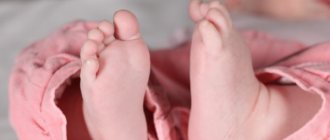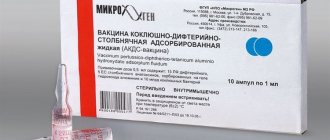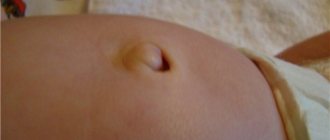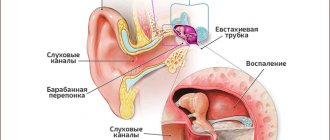Many doctors recommend giving a massage to a newborn, because the first year of a child’s life is the most important stage in his development. During this period, he acquires many skills, learning to crawl, sit, stand and walk.
Massage should be done 40 minutes before or after feeding
In our article we will look in detail at the basic techniques of this type of manipulation, note contraindications and find the answer to the question: “How to properly massage a newborn baby?”
When should you start massaging your newborn?
A mother should provide affectionate touching and stroking of her child from the first days of his birth. As for the massage itself, it can be done after the baby reaches 2-3 weeks of age. Up to 1.5 months, touch should be light. You can limit yourself to simple stroking.
But, after the child is 1.5 months old, the intensity of pressure during massage can be increased
Within reason, of course. Moreover, if during such procedures the baby becomes capricious, cries and protests, then it is better to refuse them.
At first, it is better to do the massage not for a very long time. About 5 minutes.
Video about exercises on a fitball for newborns
In this video you can find useful information on how to use a massage ball for newborns. Specific exercises are given that are acceptable for use in healthy children from birth, unless there are special contraindications. How to make classes not only useful, but also enjoyable for both the parent and the baby.
For every parent, the birth of their child is the most exciting and anticipated event. But young mothers and fathers are simply afraid to touch the newborn, because he seems so fragile. Has your baby been prescribed massage courses? Do you find them useful or not? Share your practical experience with our readers in the comments, and perhaps give some good advice.
How to properly massage a newborn?
It is so arranged by nature that in newborns the skin analyzer is developed much better than the auditory and visual analyzers. This means that at first the child tries to perceive the world around him through his mother’s touch. By performing a simple massage, the mother simultaneously develops motor, speech, auditory and visual functions in her child.
When carrying out this procedure in infants, it is important to adhere to the following rules:
- Touches should be light and gentle
- With this procedure you need to start moving from the periphery to the center
- Pressing and rubbing movements should not be allowed
- When massaging the abdomen, you need to bypass the area of the right hypochondrium
- When massaging large parts of the body, it is important not to forget about the feet and palms
- You need to start a massage with 5 minutes a day. At a maximum, this procedure should take no more than 10 minutes.
Foot massage. In order to massage the legs, you need to take the baby’s leg in your hand and, with careful stroking movements, “walk” along the outer and inner parts of the lower leg. You need to move from the foot to the thigh.
IMPORTANT: During a leg massage, do not touch the area with the kneecap. A newborn's joints are still too weak and even light touches can harm them.
Hand massage. The child should lie on his back, with his feet turned towards the one who will perform the massage. It is necessary to take the child's hand so that the thumb is inserted into it. Stroking movements should begin from the hand, moving towards the shoulder. The elbow joint must be bypassed.
Back massage. To carry out this massage, you need to place the child on his stomach. His hands should be under his chest.
This pose itself develops the child’s muscles well.
He tries to keep his head up.
IMPORTANT: Until 3 months of age, it is important to help the child maintain a stable position in this position.
Stroking the back should be done with the back of the hand, moving from the buttocks to the head. Then you need to turn your palm over and perform the same movements, but in the opposite direction.
Abdominal massage. You need to massage your stomach with light stroking movements in a clockwise direction. It is important to completely avoid pressure. The heart and liver area should be skipped. For boys, with such a massage it is important not to touch the genital area.
After such movements, you can move on to rubbing the transverse and oblique abdominal muscles. You need to start from the sides and lead to the area above the navel.
Next you need to move on to rubbing the oblique and transverse muscles. To do this, you need to place your palms under the child’s lumbar region and at the same time move them along the external oblique abdominal muscles, starting from the sides until the palms join above the navel.
How not to harm your baby during a massage?
So, what features of the procedure do parents need to know so as not to accidentally harm the child? Manipulation can be carried out no earlier than 20 days after the baby is born.
You need to massage your baby's body starting from the neck and moving towards the feet. In this case, the maximum effect of the procedure will be achieved. You should not make clapping or pressing movements so that the child does not experience stressful sensations.
There is also no need to force the baby to lie still; over time, he will adapt and behave more calmly. And, of course, the parents themselves should have a correct understanding of the procedure technique and the age at which a newborn is given a massage.
By consulting with a massage therapist and studying special literature, parents will be able to establish contact with the baby, improve his health, calm him and give him pleasure.
How to massage a newborn with colic?
It takes some time for the enzyme system to form in a newborn. That is why colic is a very common illness in all infants. They cause painful discomfort. Because of which the baby becomes capricious. Cannot eat or sleep normally.
With colic, a child may scream, grunt and refuse to eat. He may have belching and gag reflexes. Massage can be an excellent solution for colic in a newborn. This procedure can be started at the first sign of this problem. With its help, you can protect your baby from pain in the abdomen and reduce the risk of developing an umbilical hernia.
Massage for colic in infants is a rather complicated procedure.
- It is important to carry it out very carefully. To do this, you need to do circular stroking (clockwise) on the abdomen. You cannot perform more than 5-6 such strokes in one procedure.
- After this procedure has been carried out, you need to take the newborn’s legs in your hands and bend and straighten them. At the same time, in the “bending” phase, the legs should be brought as close to the stomach as possible. In one procedure you need to perform 8 flexions and extensions
- Also, if you have the problem described above, you can use an exercise such as a bicycle. To do this, you need to put the child on his back, take his legs and, simulating torsion, bend the right and left legs several times alternately
- Also, for colic, you can use such a technique as “House”. To do this, you need to place your palms on the child’s lower back and make grasping movements in the area of the oblique muscles and connect your hands above the navel. This procedure can cope with colic caused by increased gas formation, as well as constipation.
- Massage for colic will not only help cope with intestinal problems, but also strengthen your baby’s muscles
Contraindications for massage
The following reasons may be contraindications for the procedure for a newborn:
- Acute febrile illnesses
- Atrophy
- Purulent and other acute inflammatory lesions of the skin, lymphatic system, muscles and bones
- Brittle and painful bones
- Acute rickets, hyperesthesia
- Congenital heart defects
- Various forms of hemorrhagic diathesis, hemophilia
- Acute jades
- Acute hepatitis
- For large hernias, with significant prolapse of organs or with a high risk of strangulation.
To summarize, we note that if you follow the recommendations of specialists and your family doctor, as well as carry out the massage procedure correctly, it will become the key to your baby’s health. Tactile contact with the mother will bring only positive emotions to the child and will play an important role in communication between parents and their child.
You may be interested in: List of things for a newborn for the first time
How to massage the lacrimal canal for newborns?
For normal functioning of the eyes, they need to be moisturized.
Tears can cleanse the eyes of dust and other contaminants. It reaches the cornea through the lacrimal duct. Recently, cases of congenital blockage of this canal have become increasingly recorded. And if the tear fails to come out, this can lead to serious pathologies:
- Inflammation of the eyes of a purulent or mucous nature
- Redness of the eyes
- Swelling in the area of the lacrimal sac
One way to solve this problem is to massage the tear duct. This procedure can be done at home. But, in order to avoid infection, it is important to maintain sterility during such a massage. It should be performed only with special rubber gloves and after thorough hand disinfection.
Immediately before the massage of the lacrimal canal itself, the child should be placed on a flat surface (for example, on a changing table) on his back.
Tear duct massage technique:
- It is necessary to feel the lacrimal sac in the inner corner of the eye
- Lightly press on it
- If pus comes out, it must be collected with sterile cotton wool.
- In this case, the eye itself needs to be washed with a solution of furatsilin or chamomile infusion
- First, the massage is carried out with movements from the lacrimal sac to the upper brow ridges
- Then, from the inner corner down to the tip of the nose
IMPORTANT: Massage of the lacrimal canal is carried out with jerky movements of 15 presses. With their help, you can facilitate the release of what is clogged in the channel.
The procedure for this massage is quite simple. But at the same time, she is very responsible. If you are worried that you may harm your child, then it is better to perform the first procedure with the help of a specialist. And the next ones can be easily done at home.
Timely massage of the lacrimal canal in most cases can prevent a more painful procedure - probing.
Massage for dacryocystitis for a newborn, video
How to do it yourself?
It’s not difficult to massage a 1-month-old baby yourself. But you need to know certain rules of manual influence. If the procedure is carried out incorrectly, this can lead to a number of problems.
Massage for muscular dystonia
It is advisable to take a massage course with your child from a specialist and observe how the doctor works. It is also recommended to examine the baby, identify his weak points and pay special attention to them. Regarding how to massage a baby, you should consult a doctor.
There are general manual techniques. But for some children an individual massage complex is developed. It is important to take into account the physiological characteristics of the baby. This will help determine time limits, frequency and number of procedures.
Optimal time to start massage:
- 1-2 months . Manual influence at this time helps to normalize the psycho-emotional state and adapt the child to new living conditions;
- 2.5-4 months . This is the optimal period to eliminate the remaining stiffness in the baby after childbirth. Sessions help the baby learn to roll over from back to stomach and develop a grasping reflex;
- 6-8 months . Massage at this stage of development will help the baby quickly learn to sit, crawl, and turn from his stomach to his back. Muscle tone is also normalized, the body becomes more resilient and elastic;
- 9-11 months . This is the period when it is necessary to prepare the infant for the transition to a vertical position. The baby needs strength to maintain his body weight. Stable coordination of movement is important. The complex of manual interventions is developed taking into account such needs of the child.
When to start massage is up to the parents to decide. But it is better to start carrying out such procedures as early as possible.
Before you start a massage, you need to learn a number of rules:
- All rings from the fingers should be removed before manual treatment, and nails should be trimmed. This is necessary so as not to damage the baby’s delicate skin or cause him pain;
- the room temperature should be within +18-22 degrees;
- the session should be carried out on a hard, smooth surface;
- use special massage oil;
- the room in which the session is planned must be well ventilated;
- massage should be done half an hour before or 45 minutes after feeding;
- if the child is not feeling well, it is better to refuse the procedure;
- during manual intervention, you need to monitor the baby’s reaction. This will help you find out how he feels, whether he likes the massage or not;
- perform the procedure while the baby is awake. It is not recommended to wake up the baby if he falls asleep at the time when the session is planned;
- You can’t massage points on the body if you don’t know what they are responsible for;
- The session should begin with stroking. The child should relax and get used to the hands. You need to stroke the whole body, limbs, head. Then perform rubbing movements. Particular attention should be paid to the abdomen, delicate areas of the head, and groin area. Here you need to act carefully. After rubbing, it is recommended to do effleurage (especially indicated for overweight babies). The session is completed with the same types of influence, but in reverse order.
Massage for constipation in newborns
As in cases with colic, a newborn’s intestines that are not 100% formed can lead to pathological stool retention. They can be regular (chronic) or occur from time to time. In this case, constipation may be caused by changes in diet. In any case, massage is an effective way to prevent such a problem or solve it.
IMPORTANT: Unlike other means of solving the problem of constipation in newborns, massage is not addictive and does not disrupt the proper development of intestinal motility.
With constipation, feces are dense and hard balls. When emptying, the child may cry, strain hard, and the abdomen will be visually enlarged. But, even if a child has regular bowel movements, but the stool is dry, this is one of the signs of constipation.
There are many reasons for this illness.
But, most often, constipation is caused by the introduction of complementary foods or the mother’s violation of the diet during breastfeeding.
In case of pathological stool retention in a child, massage should be performed 2-3 times a day. Before this procedure, you need to wash your hands and apply a small amount of oil to them.
Before the massage, you need to undress the child and place him on a hard surface. It is very important. If the surface is not hard, the child will bend in the spine. Which will lead to displacement of internal organs and massage for constipation can lead to the opposite effect.
IMPORTANT: You cannot massage immediately after the baby has eaten. If the child is capricious, then it is also better to refuse this procedure. To effectively influence the child’s intestines, it is necessary that his abdominal wall is relaxed. And this can only be achieved if the child is calm.
- Many mothers consider the massage procedure to help the baby with bowel movements. This is true, but only partly. Much more important is the second function of such a massage - intestinal training. A correctly performed procedure will help normalize intestinal function and, over time, completely get rid of this problem.
- A massage session for constipation should not exceed 10 minutes. You need to start with soft strokes. You need to stroke your baby's tummy clockwise. You cannot press or plunge your hand into the abdomen. Movements should be soft and smooth. You can only touch the baby’s tummy with an open palm.
- At the end of the massage, you can use the edge of your palm and make several movements along the intestine. You need to move your hand from the right iliac region through the right and then the left hypochondrium. The pattern of movements should resemble the letter “P”. At the bottom point you need to increase the pressure a little
- After this procedure, the child must be turned onto his stomach and the area of the shoulder blades and pelvis stretched. After which he needs to be put back on his back again and the following movements are carried out with his legs that were described during the massage for colic: cycling, squeezing and unclenching the legs
- This massage should be completed with soothing stroking of the tummy.
General massage rules
Before giving a massage to a newborn, you need to choose the right moment . The baby should be active and well-fed, but sessions should not be performed on a full stomach either. At least 40 minutes must have passed since the last feeding.
The room where the massage is performed should be light and warm enough . It is convenient to massage the baby on a changing table or a fairly hard sofa . The surface can be covered with a disposable absorbent diaper - in case of surprises.
It is better to have a couple of toys on hand that attract the child's attention. One of them can be fixed at his eye level - while the baby looks at it with enthusiasm, you can spend half a massage session.
Massage for a hernia in a newborn, video
- Since newborns have a rather weak muscle frame (especially in the abdominal wall and abdominal area), this can lead to a pathology such as an umbilical hernia. This disease in adulthood can be treated with surgery. But, in newborns, noticeable success can be achieved with the help of massage and exercises to improve muscle tone.
- The above procedures can help a child cope with an umbilical hernia. As a rule, by the age of three you can get rid of this problem.
- Ideally, it is better to entrust this procedure to a specialist. But parents can also perform this massage on their own at home. True, it is better to do the first procedure under the guidance of a specialist. He will be able to point out some of the nuances of such a massage.
- Massage for umbilical hernia can be started two weeks after the birth of the baby. The only caveat is the wound on the navel. It must heal before using this procedure.
- Before such a massage, the child should not be fed. The touches themselves should be light and unobtrusive. The child must not be injured. Massage for umbilical hernia is aimed primarily at developing the tone of the abdominal and peritoneal muscles
In any case, it is necessary to start a massage for a newborn with light strokes.
The first movements should be clockwise. After which you can move on to pinching in the navel area. This massage should be completed with soothing soft strokes.
When the baby is one month old, you can add rubbing to the movements described above. You can help your child cope with an umbilical hernia by applying pressure to special points on the abdomen. Such pressure should be performed at a fast pace and not very deep. It is important to consult your pediatrician before using such acupressure.
Hernia diagram
After such a massage, the child must be dressed immediately. You can feed him in 30-40 minutes.
Step-by-step technique + pictures
Every new mother needs to know how to massage her newborn. To do this, you need to follow the step-by-step instructions given below.
First, you need to prepare a warm blanket, lotion or massage oil, as well as a light diaper to cover your baby if necessary. Manipulations should be carried out in a well-ventilated room with dim lighting. Light that is too bright can frighten the child and make him agitated.
- Place your baby on the bed and sit next to him so that you both feel comfortable.
- Place a towel under your baby and remove his diaper and excess clothing. It may be a good idea to place a moisture-wicking blanket under the towel to prevent unwanted wetness of the bed.
- Lotion or oil must be poured onto your own hands and warmed up slightly before starting the massage. Cold oil can be frightening to a newborn.
- You should start by establishing contact between mother and child. Talk to the baby and make him feel comfortable. After this, you need to put your hands on the baby’s shoulders and gently stroke them towards the feet. Only after this can you move on.
- Place your hand on your baby's belly and begin to massage it gently. The hand must be placed horizontally under the ribs and slowly move it down, then repeat the same with the second hand. Next, place your fingertips on your stomach and massage clockwise, while lightly pressing on it.
- We move our hands to the middle of the chest and gently massage from the middle to the edges. It is necessary to repeat the movements several times.
- Massage your entire side from the shoulder to the hip. This is done on both sides.
- Massage your newborn's arms and legs. Raise the baby's arm so that it is not fully extended at the elbow joint. Thus, it will form the letter C. You need to make sure that there is still enough oil on your hands so that the baby’s skin does not tighten. Gently stroke his handle from the shoulder to the wrist.
- Without strong pressure, using simple finger pressure, knead the child’s palms and fingers. Next, using circular movements, move along the surface of your palm. Lightly squeeze each finger in turn, but it is permissible to pull them lightly.
- The legs are massaged in the same way. It is only important to avoid the knee area, as well as the lymph nodes that are located under the knees and in the groin area.
- To prevent flat feet, it is necessary to carefully work on the instep of the foot. Just don’t be too zealous with the pressure, so as not to cause discomfort to the baby.
- Now it's time to turn the baby onto his tummy. Make sure that the airways are not blocked by the towel so that the baby can breathe fully. Start with soft and stroking movements, gradually increasing their intensity. Hands should move horizontally, towards each other, making zigzag movements. The path of the hands should intersect, but there should be no actual contact. This can cause trauma to delicate skin. Thoroughly massage the entire space from neck to butt. At the same time, you cannot massage the neck muscles, because they are not yet strong enough in the newborn. This type of massage can only be performed by a specialist.
- Place the fingers of both hands on the baby's back at some distance from the spine. It should feel like your hands are a kind of rake. Make several movements up and down.
- Massage your baby's feet again. They have a huge number of nerve endings, the stimulation of which will have a beneficial effect on the functioning of all internal organs. Not only rubbing movements are allowed, but also light tapping on the lower surface of the foot.
- After the procedure is completed, you can turn the baby back, put on a diaper and clothes appropriate for the season. Do not forget to talk to the child throughout the massage, soothe him with your voice and gaze. Try to make the movements as pleasant as possible for the baby. If he still got scared and became capricious, then it is better to postpone physical procedures until next time. Otherwise, a persistent rejection may develop that will be extremely difficult to overcome.
Massage of the hip joints for a newborn
- According to statistics, 5% of newborn children are diagnosed with hip dysplasia. It is expressed in congenital dislocation of the head of the hip joint
- This unpleasant disease can negatively affect the development of the baby and bring a lot of inconvenience in the future. Massage is indicated for the treatment of this disease.
- This procedure should be carried out from the first days of the baby’s birth. With daily massage there is a 100% chance of getting rid of this problem.
- Begin the massage of the hip joint by stroking the legs from the shin to the thigh. This needs to be done for 2-3 minutes so that the baby can relax and get used to such touches.
Then you need to stretch the muscles of your legs.
You need to feel the muscles, but do not put too much pressure on them. This can only harm the baby.
IMPORTANT: Do not massage the inner thigh. There are lymph nodes there, which can be damaged if the massage is performed carelessly.
After the movements described above, you need to take the baby’s legs and carry out movements similar to opening and closing a book. Such movements must be done 50-60 times. After which the child should be placed on his tummy and his back and buttocks should be stretched.
IMPORTANT: To stretch your child’s buttocks, you must first place him in the frog position and pull his legs towards his butt and back. The number of such movements is 40-50 times.
This massage should be avoided if the child has a high temperature, problems with the cardiovascular system, an acute form of diathesis, a hernia, etc. Therefore, before carrying out it, it is necessary to consult a specialist. He can also show you how to do this massage correctly.
Diseases that can be cured in a baby with massage:
- problems with the musculoskeletal system: clubfoot, scoliosis, flat feet, dysplasia.
- diseases of a therapeutic nature: hernia, hypotonia, hypertonicity, rickets, malnutrition and torticollis.
- respiratory diseases: bronchitis, bronchial asthma, pleurisy, rhinitis.
- problems with the gastrointestinal tract
- diseases of the central nervous system.
Attention! Do not make a diagnosis yourself and do not self-medicate! Remember that the diagnosis can only be made by the attending pediatrician, preferably with a good reputation and long-term experience!
Newborn neck massage
The neck is one of the most vulnerable places in an infant. After a few days of life, he actively begins to move his head, which can cause problems with this part of the body. The load from a heavy head, proportional to the rest of the body, can cause problems with the spine in the cervical region. In order to help him, it is necessary to train the neck muscles.
Neck massage can help with this
In addition to its main function, neck massage helps:
- Improve blood circulation to the brain
- Increase skin tone
- Correct defects received by the child at birth
- Relieve muscle hypertonicity
Most often, neck massage for infants is performed for preventive purposes. For the baby, lay on the stomach and gently stroke the shoulders and neck to the hair growth area. After several preparatory movements, you need to move on to wave-like kneading of the neck. With them, it is important to act on the muscles, and not on the spine.
After such movements, you need to go back to stroking. And then, when the baby calms down, knead the neck muscles with your fingertips. It is important to count your strength. If the baby experiences discomfort, the massage procedure must be stopped.
This procedure should be completed with light soothing movements.
Massage has proven itself very well for children with curvature of the neck caused by birth trauma or pathology in the development of the fetus. To get rid of this problem, massage begins from 2 weeks of age. But, only a specially trained person should perform such a procedure. It is important to trust a professional when giving your child therapeutic massage.
Benefits / advantages of massage
Multiple receptors that are present on the surface of the skin, when irritated, transmit signals to the brain. This stimulates the development of the newborn's nervous system. At the same time, massaging the skin allows you to stimulate all receptors as effectively as possible.
A huge advantage of physiotherapy is the improvement of blood circulation, and, accordingly, blood flow to the diseased organ, which has a beneficial effect on its functions. Therefore, sessions of preventive physical procedures are recommended for children even before they reach one year of age.
Physiotherapy is especially important for premature babies born during premature birth. It is for their full development that it is necessary to carry out preventive massages that will contribute to the formation of correct posture.
In newborns, visual and auditory receptors are not yet sufficiently developed. Therefore, the baby feels the entire world around him, first of all, through touch. Massaging the skin allows all organ systems to develop harmoniously, and thanks to such manipulations, the immune system is strengthened. Physiotherapy sessions are also beneficial for newborns because they prevent colic and constipation. However, in addition to this, the mother needs to monitor her diet while breastfeeding.
When is a massage needed?
It is necessary to clearly distinguish between preventive and therapeutic massages. And therefore the indications for them are different.
Medical indications for therapeutic physiotherapy:
- flat feet, various leg deformities, as well as clubfoot;
- cerebral palsy;
- rickets;
- hypotonicity or hypertonicity of muscles;
- various lesions of the central nervous system;
- hernia in the umbilical region;
- hip dysplasia;
- torticollis;
- scoliosis;
- also as adjunctive therapy for upper respiratory tract infections.
However, not only sick newborns need massage. After all, it is he who helps the child better adapt to environmental conditions, and also stimulates the physical and mental development of the baby. In a period of up to a year, it is enough to take three or four courses to give impetus to further development.
When is preventive massage necessary?
- At the age of three to four months - helps to overcome muscle rigidity, as well as learn to roll over from back to stomach and grab objects with hands.
- At the age of six months to eight months, the child learns to sit, crawl, and also roll over from his stomach to his back. Additionally, it is recommended to introduce gymnastic exercises.
- Upon reaching nine to ten months, the baby must have sufficiently developed skeletal muscles to master upright walking. And a huge advantage in this matter will be massaging the main corset muscles.











